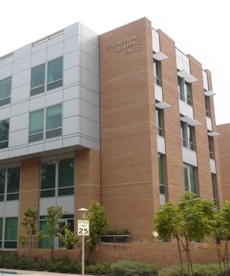
|

|
Ev ve Ofis taşıma sektöründe lider olmak.Teknolojiyi klrd takip ederek bunu müşteri menuniyeti amacı için kullanmak.Sektörde marka olmak.
İstanbul evden eve nakliyat
Misyonumuz sayesinde edindiğimiz müşteri memnuniyeti ve güven ile müşterilerimizin bizi tavsiye etmelerini sağlamak.
Editorial introduction to the special issue on ‘‘Image Understanding for Real-World Distributed Video Networks’’
![]() Surveillance cameras are an essential component of the overall crime prevention strategy and Law Enforcement agencies now heavily use imagery collected by surveillance cameras in
solving crimes. Cameras installed on roadways are used to collect traffic data with the aim to better manage traffic, relieve congestion, respond to accidents, etc. Surveillance
cameras are also used in high-stake public places, such as airport, train stations, metro stations and bus terminals. In recent years, cameras have also been used to record and
prevent incidents of police brutality. In short, as a society, we are increasingly reliant on cameras.
Surveillance cameras are an essential component of the overall crime prevention strategy and Law Enforcement agencies now heavily use imagery collected by surveillance cameras in
solving crimes. Cameras installed on roadways are used to collect traffic data with the aim to better manage traffic, relieve congestion, respond to accidents, etc. Surveillance
cameras are also used in high-stake public places, such as airport, train stations, metro stations and bus terminals. In recent years, cameras have also been used to record and
prevent incidents of police brutality. In short, as a society, we are increasingly reliant on cameras.
Camera Pan / Tilt Control with Multiple Trackers
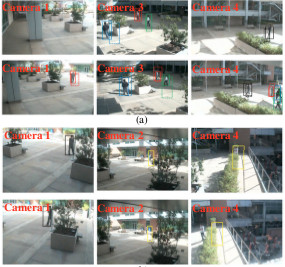 In this paper, we consider the multi-camera
tracking and the camera active control (pan and tilt).
Auction mechanism from economics is developed to
choose the best available camera. By modeling the
camera bids with prior knowledge of the camera
homographies, the system can "think" ahead to
perform necessary panning or tilting operations. The
uncertainties of homographies are considered
inherently in the metrics used for computing camera
bids. Further, to have a better tracking result, we use
multiple trackers simultaneously. The trackers are
rectified periodically based on the previous auction
results. The proposed approach is evaluated in a realworld
camera network.
In this paper, we consider the multi-camera
tracking and the camera active control (pan and tilt).
Auction mechanism from economics is developed to
choose the best available camera. By modeling the
camera bids with prior knowledge of the camera
homographies, the system can "think" ahead to
perform necessary panning or tilting operations. The
uncertainties of homographies are considered
inherently in the metrics used for computing camera
bids. Further, to have a better tracking result, we use
multiple trackers simultaneously. The trackers are
rectified periodically based on the previous auction
results. The proposed approach is evaluated in a realworld
camera network.
Design and Optimization of the VideoWeb Wireless Camera Network
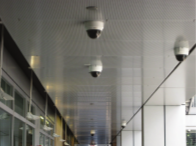 Sensor networks have been a very active area of research in recent years. However, most of the
sensors used in the development of these networks have been local and nonimaging sensors.
The emerging development of video sensor networks poses its own set of unique challenges, including high-bandwidth and low latency
requirements for real-time processing and control. This paper presents a systematic approach by detailing the design, implementation, and evaluation of a large-scale wireless camera network, suitable for
a variety of practical real-time applications. We take into consideration issues related to hardware,
software, control, architecture, network connectivity, performance evaluation, and data-processing
strategies for the network. We also perform multiobjective optimization on settings such as video resolution
and compression quality to provide insight into the performance trade-offs when configuring such
a network and present lessons learned in the building and daily usage of the network.
Sensor networks have been a very active area of research in recent years. However, most of the
sensors used in the development of these networks have been local and nonimaging sensors.
The emerging development of video sensor networks poses its own set of unique challenges, including high-bandwidth and low latency
requirements for real-time processing and control. This paper presents a systematic approach by detailing the design, implementation, and evaluation of a large-scale wireless camera network, suitable for
a variety of practical real-time applications. We take into consideration issues related to hardware,
software, control, architecture, network connectivity, performance evaluation, and data-processing
strategies for the network. We also perform multiobjective optimization on settings such as video resolution
and compression quality to provide insight into the performance trade-offs when configuring such
a network and present lessons learned in the building and daily usage of the network.
Auction Protocol for Camera Active Control
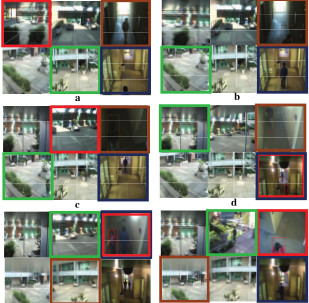 In this paper, we apply the auction-based theories in
economics to camera networks. We develop a set of auction
protocols to do camera active control (pan/tilt/zoom)
intelligently. Unlike the economic auction, the bid price in
our case is formulated to have a vector representation, such
that when a camera is available to follow multiple objects,
we consider the "willingness" of this camera to track a
particular object. Most of the computation is decentralized
by computing the bid price locally while the final decision is
made by a virtual auctioneer based on all the available bids,
which is analogous to a real auction in economics. Thus, we
can take the advantages of distributed/centralized
computation and avoid their pitfalls. The experimental
results show that the proposed approach is effective and
efficient for dynamically active control based on user
defined performance metrics.
In this paper, we apply the auction-based theories in
economics to camera networks. We develop a set of auction
protocols to do camera active control (pan/tilt/zoom)
intelligently. Unlike the economic auction, the bid price in
our case is formulated to have a vector representation, such
that when a camera is available to follow multiple objects,
we consider the "willingness" of this camera to track a
particular object. Most of the computation is decentralized
by computing the bid price locally while the final decision is
made by a virtual auctioneer based on all the available bids,
which is analogous to a real auction in economics. Thus, we
can take the advantages of distributed/centralized
computation and avoid their pitfalls. The experimental
results show that the proposed approach is effective and
efficient for dynamically active control based on user
defined performance metrics.
Task-oriented camera assignment in a video network
.png) Camera assignment and hand-off are some of the key image processing problems in a video network. In this paper, we propose a new approach for camera assignment and handoff in a video network. The camera assignment problem is modeled as a weakly acyclic game which allows the design of utility functions based on different user-supplied criteria. A theoretical and experimental comparison of the proposed approach with the two recently proposed approaches based on potential game theory and constraint satisfaction problem is provided. This comparison shows that the proposed approach is theoretically more general and computationally more efficient than the other approaches.
Camera assignment and hand-off are some of the key image processing problems in a video network. In this paper, we propose a new approach for camera assignment and handoff in a video network. The camera assignment problem is modeled as a weakly acyclic game which allows the design of utility functions based on different user-supplied criteria. A theoretical and experimental comparison of the proposed approach with the two recently proposed approaches based on potential game theory and constraint satisfaction problem is provided. This comparison shows that the proposed approach is theoretically more general and computationally more efficient than the other approaches.
VideoWeb: Design of a Wireless Camera Network for Real-time Monitoring of Activities
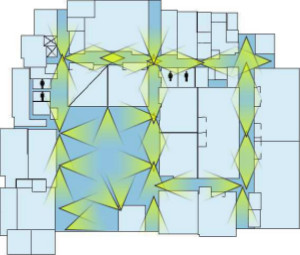 Sensor networks have been a very active area of
research in recent years. However, most of the sensors used in
the development of these networks have been local and nonimaging
sensors such as acoustics, seismic, vibration, temperature,
humidity, etc. The development of emerging video sensor
networks poses its own set of unique challenges, including high
bandwidth and low latency requirements for real-time processing
and control. This paper presents a systematic approach for the
design, implementation, and evaluation of a large-scale, softwarereconfigurable,
wireless camera network, suitable for a variety of
practical real-time applications. We take into consideration issues
related to the hardware, software, control, architecture, network
connectivity, performance evaluation, and data processing strategies
for the network. We perform multi-objective optimization
on settings such as video resolution and compression quality to
provide insight into the performance trade-offs when configuring
such a network.
Sensor networks have been a very active area of
research in recent years. However, most of the sensors used in
the development of these networks have been local and nonimaging
sensors such as acoustics, seismic, vibration, temperature,
humidity, etc. The development of emerging video sensor
networks poses its own set of unique challenges, including high
bandwidth and low latency requirements for real-time processing
and control. This paper presents a systematic approach for the
design, implementation, and evaluation of a large-scale, softwarereconfigurable,
wireless camera network, suitable for a variety of
practical real-time applications. We take into consideration issues
related to the hardware, software, control, architecture, network
connectivity, performance evaluation, and data processing strategies
for the network. We perform multi-objective optimization
on settings such as video resolution and compression quality to
provide insight into the performance trade-offs when configuring
such a network.
A Comparison of Techniques for Camera Selection and Handoff in a Video Network
 Video networks are becoming increasingly important for solving many real-world problems. Multiple video sensors,
usually cameras, require collaboration when performing various tasks. One of the most basic tasks is the tracking of
objects, which requires mechanisms to select a camera for a certain object and hand-off this object from one
camera to another so as to accomplish seamless tracking. In this paper, we provide a comprehensive comparison
of current and emerging camera selection and hand-off techniques. We consider geometry, statistics, and game theory-based
approaches and provide both theoretical end experimental comparison using centralized and distributed computational
models. We provide simulation and experimental results using real data for various scenarios of a large number
of cameras and objects for in-depth understanding of strengths and weaknesses of these techniques.
Video networks are becoming increasingly important for solving many real-world problems. Multiple video sensors,
usually cameras, require collaboration when performing various tasks. One of the most basic tasks is the tracking of
objects, which requires mechanisms to select a camera for a certain object and hand-off this object from one
camera to another so as to accomplish seamless tracking. In this paper, we provide a comprehensive comparison
of current and emerging camera selection and hand-off techniques. We consider geometry, statistics, and game theory-based
approaches and provide both theoretical end experimental comparison using centralized and distributed computational
models. We provide simulation and experimental results using real data for various scenarios of a large number
of cameras and objects for in-depth understanding of strengths and weaknesses of these techniques.
Anomalous Activity Classification in the Distributed Camera Network
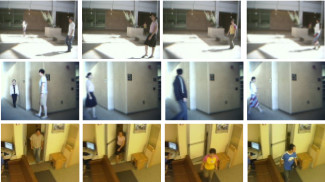 Unlike existing methods that used the human actions or
trajectories to analyze the human activity in overlapping
field-of-views, this paper proposes the appearance and travel
time-based human activity classification in the camera
network of non-overlapping field-of-views. The mixture of
Gaussian-based appearance similarity model incorporates
the appearance variance between different cameras to
address changes in varying lighting conditions. To address
the problem of limited labeled training data, we propose the
use of semi-supervised Expectation-Maximization algorithm
for activity classification. The human activities observed in a
simulated camera network with nine cameras and twentyfive
nodes are classified into one normal and three
anomalous classes. A similar camera network is built and
tested in real-life experiments, in which the proposed
approach achieves satisfactory performance.
Unlike existing methods that used the human actions or
trajectories to analyze the human activity in overlapping
field-of-views, this paper proposes the appearance and travel
time-based human activity classification in the camera
network of non-overlapping field-of-views. The mixture of
Gaussian-based appearance similarity model incorporates
the appearance variance between different cameras to
address changes in varying lighting conditions. To address
the problem of limited labeled training data, we propose the
use of semi-supervised Expectation-Maximization algorithm
for activity classification. The human activities observed in a
simulated camera network with nine cameras and twentyfive
nodes are classified into one normal and three
anomalous classes. A similar camera network is built and
tested in real-life experiments, in which the proposed
approach achieves satisfactory performance.
|
|


 In this paper, we consider the multi-camera
tracking and the camera active control (pan and tilt).
Auction mechanism from economics is developed to
choose the best available camera. By modeling the
camera bids with prior knowledge of the camera
homographies, the system can "think" ahead to
perform necessary panning or tilting operations. The
uncertainties of homographies are considered
inherently in the metrics used for computing camera
bids. Further, to have a better tracking result, we use
multiple trackers simultaneously. The trackers are
rectified periodically based on the previous auction
results. The proposed approach is evaluated in a realworld
camera network.
In this paper, we consider the multi-camera
tracking and the camera active control (pan and tilt).
Auction mechanism from economics is developed to
choose the best available camera. By modeling the
camera bids with prior knowledge of the camera
homographies, the system can "think" ahead to
perform necessary panning or tilting operations. The
uncertainties of homographies are considered
inherently in the metrics used for computing camera
bids. Further, to have a better tracking result, we use
multiple trackers simultaneously. The trackers are
rectified periodically based on the previous auction
results. The proposed approach is evaluated in a realworld
camera network.
 Sensor networks have been a very active area of research in recent years. However, most of the
sensors used in the development of these networks have been local and nonimaging sensors.
The emerging development of video sensor networks poses its own set of unique challenges, including high-bandwidth and low latency
requirements for real-time processing and control. This paper presents a systematic approach by detailing the design, implementation, and evaluation of a large-scale wireless camera network, suitable for
a variety of practical real-time applications. We take into consideration issues related to hardware,
software, control, architecture, network connectivity, performance evaluation, and data-processing
strategies for the network. We also perform multiobjective optimization on settings such as video resolution
and compression quality to provide insight into the performance trade-offs when configuring such
a network and present lessons learned in the building and daily usage of the network.
Sensor networks have been a very active area of research in recent years. However, most of the
sensors used in the development of these networks have been local and nonimaging sensors.
The emerging development of video sensor networks poses its own set of unique challenges, including high-bandwidth and low latency
requirements for real-time processing and control. This paper presents a systematic approach by detailing the design, implementation, and evaluation of a large-scale wireless camera network, suitable for
a variety of practical real-time applications. We take into consideration issues related to hardware,
software, control, architecture, network connectivity, performance evaluation, and data-processing
strategies for the network. We also perform multiobjective optimization on settings such as video resolution
and compression quality to provide insight into the performance trade-offs when configuring such
a network and present lessons learned in the building and daily usage of the network.
 In this paper, we apply the auction-based theories in
economics to camera networks. We develop a set of auction
protocols to do camera active control (pan/tilt/zoom)
intelligently. Unlike the economic auction, the bid price in
our case is formulated to have a vector representation, such
that when a camera is available to follow multiple objects,
we consider the "willingness" of this camera to track a
particular object. Most of the computation is decentralized
by computing the bid price locally while the final decision is
made by a virtual auctioneer based on all the available bids,
which is analogous to a real auction in economics. Thus, we
can take the advantages of distributed/centralized
computation and avoid their pitfalls. The experimental
results show that the proposed approach is effective and
efficient for dynamically active control based on user
defined performance metrics.
In this paper, we apply the auction-based theories in
economics to camera networks. We develop a set of auction
protocols to do camera active control (pan/tilt/zoom)
intelligently. Unlike the economic auction, the bid price in
our case is formulated to have a vector representation, such
that when a camera is available to follow multiple objects,
we consider the "willingness" of this camera to track a
particular object. Most of the computation is decentralized
by computing the bid price locally while the final decision is
made by a virtual auctioneer based on all the available bids,
which is analogous to a real auction in economics. Thus, we
can take the advantages of distributed/centralized
computation and avoid their pitfalls. The experimental
results show that the proposed approach is effective and
efficient for dynamically active control based on user
defined performance metrics.
.png) Camera assignment and hand-off are some of the key image processing problems in a video network. In this paper, we propose a new approach for camera assignment and handoff in a video network. The camera assignment problem is modeled as a weakly acyclic game which allows the design of utility functions based on different user-supplied criteria. A theoretical and experimental comparison of the proposed approach with the two recently proposed approaches based on potential game theory and constraint satisfaction problem is provided. This comparison shows that the proposed approach is theoretically more general and computationally more efficient than the other approaches.
Camera assignment and hand-off are some of the key image processing problems in a video network. In this paper, we propose a new approach for camera assignment and handoff in a video network. The camera assignment problem is modeled as a weakly acyclic game which allows the design of utility functions based on different user-supplied criteria. A theoretical and experimental comparison of the proposed approach with the two recently proposed approaches based on potential game theory and constraint satisfaction problem is provided. This comparison shows that the proposed approach is theoretically more general and computationally more efficient than the other approaches.
 Sensor networks have been a very active area of
research in recent years. However, most of the sensors used in
the development of these networks have been local and nonimaging
sensors such as acoustics, seismic, vibration, temperature,
humidity, etc. The development of emerging video sensor
networks poses its own set of unique challenges, including high
bandwidth and low latency requirements for real-time processing
and control. This paper presents a systematic approach for the
design, implementation, and evaluation of a large-scale, softwarereconfigurable,
wireless camera network, suitable for a variety of
practical real-time applications. We take into consideration issues
related to the hardware, software, control, architecture, network
connectivity, performance evaluation, and data processing strategies
for the network. We perform multi-objective optimization
on settings such as video resolution and compression quality to
provide insight into the performance trade-offs when configuring
such a network.
Sensor networks have been a very active area of
research in recent years. However, most of the sensors used in
the development of these networks have been local and nonimaging
sensors such as acoustics, seismic, vibration, temperature,
humidity, etc. The development of emerging video sensor
networks poses its own set of unique challenges, including high
bandwidth and low latency requirements for real-time processing
and control. This paper presents a systematic approach for the
design, implementation, and evaluation of a large-scale, softwarereconfigurable,
wireless camera network, suitable for a variety of
practical real-time applications. We take into consideration issues
related to the hardware, software, control, architecture, network
connectivity, performance evaluation, and data processing strategies
for the network. We perform multi-objective optimization
on settings such as video resolution and compression quality to
provide insight into the performance trade-offs when configuring
such a network.
 Video networks are becoming increasingly important for solving many real-world problems. Multiple video sensors,
usually cameras, require collaboration when performing various tasks. One of the most basic tasks is the tracking of
objects, which requires mechanisms to select a camera for a certain object and hand-off this object from one
camera to another so as to accomplish seamless tracking. In this paper, we provide a comprehensive comparison
of current and emerging camera selection and hand-off techniques. We consider geometry, statistics, and game theory-based
approaches and provide both theoretical end experimental comparison using centralized and distributed computational
models. We provide simulation and experimental results using real data for various scenarios of a large number
of cameras and objects for in-depth understanding of strengths and weaknesses of these techniques.
Video networks are becoming increasingly important for solving many real-world problems. Multiple video sensors,
usually cameras, require collaboration when performing various tasks. One of the most basic tasks is the tracking of
objects, which requires mechanisms to select a camera for a certain object and hand-off this object from one
camera to another so as to accomplish seamless tracking. In this paper, we provide a comprehensive comparison
of current and emerging camera selection and hand-off techniques. We consider geometry, statistics, and game theory-based
approaches and provide both theoretical end experimental comparison using centralized and distributed computational
models. We provide simulation and experimental results using real data for various scenarios of a large number
of cameras and objects for in-depth understanding of strengths and weaknesses of these techniques.
 Unlike existing methods that used the human actions or
trajectories to analyze the human activity in overlapping
field-of-views, this paper proposes the appearance and travel
time-based human activity classification in the camera
network of non-overlapping field-of-views. The mixture of
Gaussian-based appearance similarity model incorporates
the appearance variance between different cameras to
address changes in varying lighting conditions. To address
the problem of limited labeled training data, we propose the
use of semi-supervised Expectation-Maximization algorithm
for activity classification. The human activities observed in a
simulated camera network with nine cameras and twentyfive
nodes are classified into one normal and three
anomalous classes. A similar camera network is built and
tested in real-life experiments, in which the proposed
approach achieves satisfactory performance.
Unlike existing methods that used the human actions or
trajectories to analyze the human activity in overlapping
field-of-views, this paper proposes the appearance and travel
time-based human activity classification in the camera
network of non-overlapping field-of-views. The mixture of
Gaussian-based appearance similarity model incorporates
the appearance variance between different cameras to
address changes in varying lighting conditions. To address
the problem of limited labeled training data, we propose the
use of semi-supervised Expectation-Maximization algorithm
for activity classification. The human activities observed in a
simulated camera network with nine cameras and twentyfive
nodes are classified into one normal and three
anomalous classes. A similar camera network is built and
tested in real-life experiments, in which the proposed
approach achieves satisfactory performance.